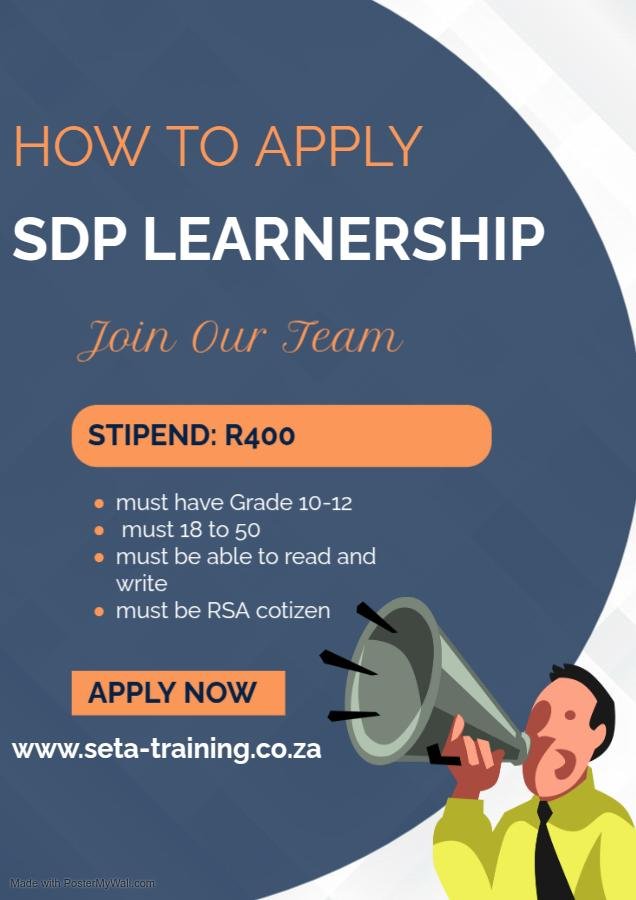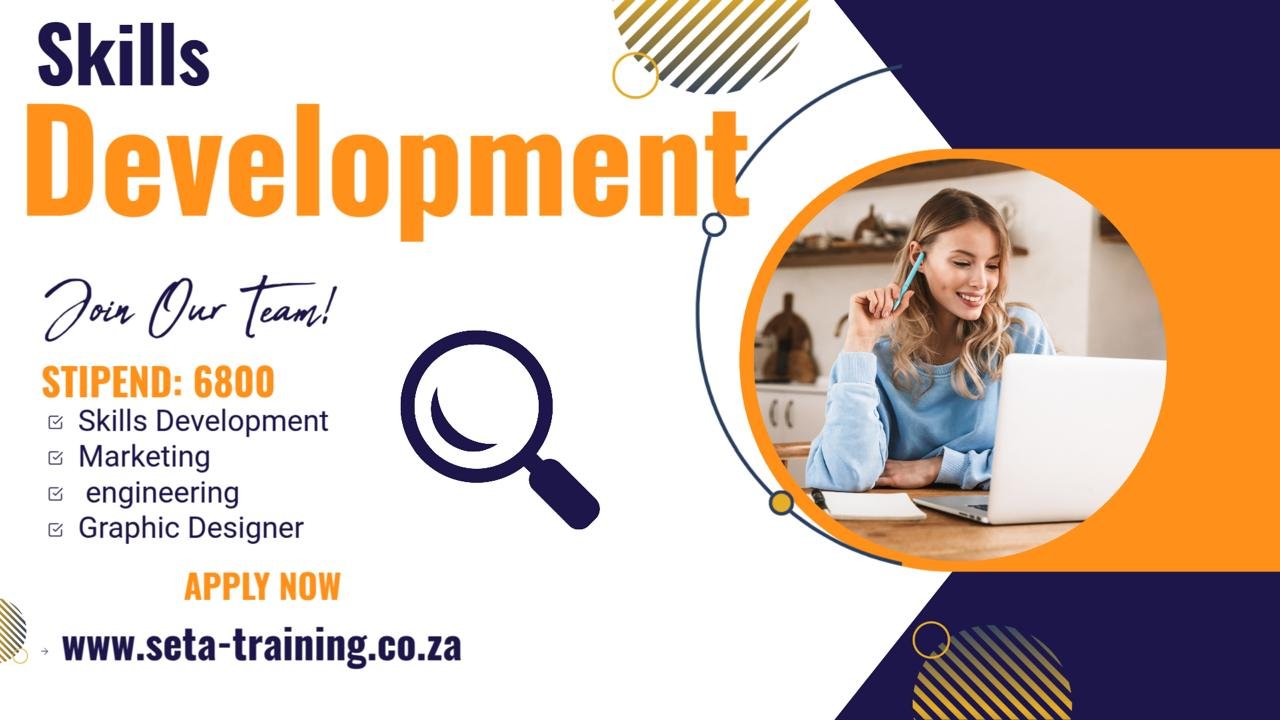Introduction
South Africa continues to face a high unemployment rate, especially among young people and first-time job seekers. One of the most effective ways to bridge the gap between education and employment is through learnerships accredited by the Sector Education and Training Authority (SETA). These programmes provide learners with both theoretical knowledge and practical workplace experience.
Among the many accredited providers, Skills Development Providers (SDPs) play a vital role in offering structured and recognized training. If you are planning to apply for an SDP learnership accredited by SETA, this comprehensive guide will take you step by step through the process.
By the end of this article, you will know:
- What SDP learnerships are
- The benefits of applying
- The eligibility requirements
- How to apply successfully
- Mistakes to avoid during the application process
- SEO-friendly tips for finding opportunities online
What is an SDP Learnership Accredited by SETA?
Understanding SETA
SETA stands for the Sector Education and Training Authority. It is a government body in South Africa responsible for promoting skills development and education in different sectors such as health, finance, transport, agriculture, and hospitality.
Role of Skills Development Providers (SDPs)
An SDP is a registered training provider that is officially accredited to deliver SETA-approved programmes. When you apply for a learnership through an SDP, you are guaranteed that the training will meet national quality standards and be recognized by employers.
What is a Learnership?
A learnership is a work-based learning programme that combines:
- Theoretical classroom training
- Practical on-the-job experience
After completing an SDP learnership, learners receive a National Qualifications Framework (NQF) certificate, which is recognized across South Africa.
Benefits of Applying for an SDP Learnership
Before learning how to apply, it is important to understand why these programmes are worth considering.
1. Gain Recognized Qualifications
Every SDP learnership accredited by SETA is aligned with the NQF standards, meaning your certificate is recognized nationally.
2. Earn While You Learn
Unlike traditional studies, most learnerships offer a monthly stipend to cover transport and basic needs.
3. Improve Employment Prospects
Employers value candidates who have both theory and workplace experience. Completing a learnership enhances your employability.
4. Pathway to Further Education
Once you finish one level, you can progress to higher-level qualifications within the same career field.
5. Skills for Entrepreneurship
Learnerships don’t only prepare you for jobs — they also equip you with practical knowledge you can use to start your own business.
Requirements for Applying
To apply for an SDP learnership accredited by SETA, you must meet specific requirements. These can differ depending on the programme, but common requirements include:
- Age – Usually between 18 and 35 years old.
- Education – A minimum of Grade 10, Grade 11, or Matric (Grade 12) depending on the learnership level.
- Citizenship – You must be a South African citizen with a valid ID.
- Employment Status – Most learnerships require you to be unemployed.
- Willingness to Learn – A positive attitude and readiness to complete both theory and workplace training.
Step-by-Step Guide: How to Apply for an SDP Learnership
Applying for an SDP learnership is simple if you follow the correct steps. Below is a detailed process to guide you.
Step 1: Research Available Learnerships
Visit official websites of SDPs and SETAs to find out which learnerships are currently open. Some trusted places to check include:
- Official SETA websites (for example, Services SETA, HWSETA, or AgriSETA)
- Accredited SDP websites
- Job portals such as Careers24, Indeed, or SAYouth
Step 2: Check Minimum Requirements
Before applying, carefully read the requirements to ensure you qualify. Applying for a learnership you don’t meet the requirements for reduces your chances of success.
Step 3: Prepare Your Documents
Most SDPs will require the following:
- Certified copy of your ID
- Certified copies of your qualifications (Matric certificate or latest report)
- Updated CV
- Proof of residence
- Application form (provided by the SDP or SETA)
Step 4: Complete the Application Form
Fill in all sections of the application form carefully. Provide correct information, as false details may disqualify you.
Step 5: Submit Your Application
Submit your application through the method specified by the SDP:
- Online submission through their website
- Email submission
- Physical hand delivery
Step 6: Prepare for Interviews or Assessments
If shortlisted, you may be called for an interview or assessment. Be ready to:
- Explain your interest in the learnership
- Share your career goals
- Demonstrate basic knowledge of the sector
Step 7: Acceptance and Signing the Contract
If successful, you will receive a learnership agreement that must be signed by three parties:
- You (the learner)
- The employer (host company)
- The training provider (SDP)
This agreement protects your rights and clearly explains your responsibilities.
Common Mistakes to Avoid
When applying for an SDP learnership accredited by SETA, avoid the following mistakes:
- Incomplete applications – Always double-check your forms and documents.
- Late submissions – Apply before the deadline.
- Using outdated contact details – Make sure your phone number and email are active.
- Not tailoring your CV – Customize your CV to highlight skills relevant to the learnership.
- Falling for scams – Learnerships are free to apply for. Never pay anyone who promises placement.
SEO Tips: How to Find and Apply Online
Many learners struggle to find reliable information online. Here are SEO-friendly strategies to make your search more effective:
1. Use Specific Keywords
When searching online, type targeted keywords such as:
- “SDP learnerships accredited by SETA 2025”
- “How to apply for SETA accredited learnerships”
- “Free learnerships for unemployed South African youth”
2. Visit Official Websites Only
Avoid suspicious sites. Stick to accredited SDP platforms or official SETA websites.
3. Subscribe to Newsletters
Many training providers offer newsletters with updates about open opportunities.
4. Engage on Social Media
Follow official SETA and SDP pages on Facebook, LinkedIn, and Twitter for announcements.
Frequently Asked Questions (FAQs)
1. Do I need to pay to apply for a learnership?
No. Learnerships are free. If someone asks for money, it is a scam.
2. Will I be employed after completing the learnership?
Employment is not guaranteed, but your chances improve because of the experience and qualification.
3. Can I apply for more than one learnership?
Yes, you can apply for multiple opportunities, but you can only enroll in one at a time.
4. Do learners receive certificates?
Yes, after successful completion, learners receive an NQF-registered qualification.
5. Are SDP learnerships available in all sectors?
Yes, different SDPs cover various industries including business, IT, agriculture, engineering, and healthcare.
Final Tips for a Successful Application
- Always keep your documents updated and certified.
- Apply early before closing dates.
- Write a short, professional motivation letter explaining why you want the learnership.
- Stay patient — recruitment can take weeks or months.
- Keep improving your skills while waiting for responses.
Conclusion
Applying for an SDP learnership accredited by SETA is a life-changing opportunity. It allows you to gain practical skills, earn a stipend, and improve your future career prospects. The process may seem overwhelming at first, but by following the steps in this guide, you can successfully apply and stand out among other applicants.
Remember: always use trusted sources, meet all requirements, and prepare yourself for interviews or assessments. With determination and preparation, your application can lead to a brighter future.



